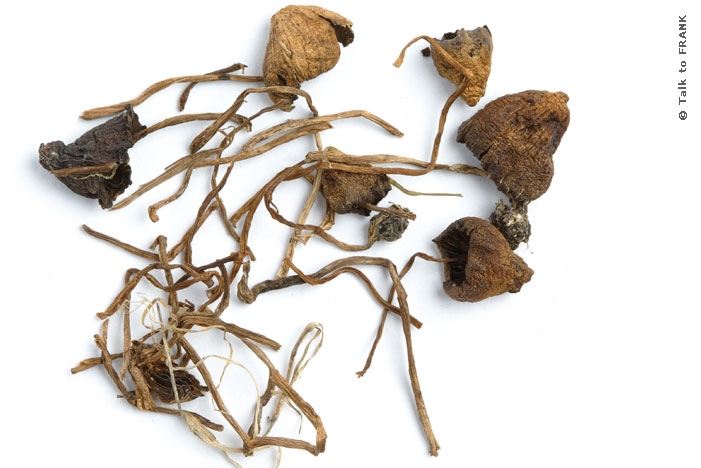Mushrooms: Difference between revisions
GrimReaper (talk | contribs) |
|||
| Line 1: | Line 1: | ||
= General Information = | = General Information = | ||
There are more than 180 species of mushrooms which contain the psychedelic chemicals psilocybin or psilocin. They have a long history of use in Mexico and are currently one of the most popular and commonly available natural psychedelics. | There are more than 180 species of mushrooms which contain the psychedelic chemicals psilocybin or psilocin. They have a long history of use in Mexico and are currently one of the most popular and commonly available natural psychedelics. | ||
== History == | |||
Ethnohistorical sources indicate that teonanacatl, the "divine mushroom" or "flesh of the gods" (Psilocybe mexicana and other species of the genus Psilocybe), was being ritually consumed and used in religious ceremonies in Mexico before the arrival of the Spanish. During the colonial period, the indigenous use of the mushroom was forbidden and brutally suppressed by the Spanish Inquisition. In spite of this, the mushroom cult has survived underground even into the present day. The psychoactive use of Psilocybe mexicana in Indian shamanism was rediscovered at the end of the 1930s. In the late 1950s, it was found that the Mixe Indians of Coadan, Oaxaca, also used Psilocybe mexicana for shamanic purposes (Hoogshagen 1959). Psilocybe mexicana was the first mushroom in which Albert Hofmann discovered the LSD-like substances psilocybin and psilocin (Heim et al. 1958; Hofmann 1958, 1959). | |||
= Dosage = | = Dosage = | ||
Revision as of 05:03, 9 June 2014
General Information
There are more than 180 species of mushrooms which contain the psychedelic chemicals psilocybin or psilocin. They have a long history of use in Mexico and are currently one of the most popular and commonly available natural psychedelics.
History
Ethnohistorical sources indicate that teonanacatl, the "divine mushroom" or "flesh of the gods" (Psilocybe mexicana and other species of the genus Psilocybe), was being ritually consumed and used in religious ceremonies in Mexico before the arrival of the Spanish. During the colonial period, the indigenous use of the mushroom was forbidden and brutally suppressed by the Spanish Inquisition. In spite of this, the mushroom cult has survived underground even into the present day. The psychoactive use of Psilocybe mexicana in Indian shamanism was rediscovered at the end of the 1930s. In the late 1950s, it was found that the Mixe Indians of Coadan, Oaxaca, also used Psilocybe mexicana for shamanic purposes (Hoogshagen 1959). Psilocybe mexicana was the first mushroom in which Albert Hofmann discovered the LSD-like substances psilocybin and psilocin (Heim et al. 1958; Hofmann 1958, 1959).
Dosage
This is the dose range for dry Psilocybe Cubensis. Fresh mushrooms are 9/10ths water by weight, and require 10 times the dose. For other types of psilocybes, see http://www.erowid.org/plants/mushrooms/mushrooms_info4.shtml.
Oral
Cubensis
Light: 1-2 grams
Common: 2-4 grams
Strong: 4+ grams
Truffles
Light: 3-7.5 grams
Common: 7.5-12.5 grams
Strong 12.5-15 grams
Heavy: 15+ grams
Lemon Tek
This will greatly increase intensity, but lower the duration. The comedown is abrupt, yet gentle. Do not expect enough time for introspection.
Grind the mushrooms to a fine powder, then add them to an acidic solution (e.g. 1 tbps lemon juice, 8oz water), and drink on an empty stomach.
Duration
Total: 4-8 hours
Effects
Psilocybin tends to induce more introspection than other psychedelics.
Positive
- Mood lift, euphoria
- Increased giggling and laughing

- Creative, philosophical or deep thinking : ideas flow more easily
- Boring tasks or entertainment can become more interesting or funny
- Sensation of insight
- Life-changing spiritual experience
- Intense feelings of wonder
- Paradoxical feeling of a normalcy and deep alteration of psyche
- May interrupt cluster sequences in those suffering from cluster headaches
Neutral
- Feeling more emotionally sensitive
- General change in consciousness (as with many psychoactives)
- Time perception alteration [ Wittmann 2006 ]
- Time seems to pass more slowly (minutes seem to take hours)
- Sensitivity to light; lights seem brighter
- Starring and rainbow patterns around pinpoint lights
- Increased detection of motion in peripheral vision
- Open and closed-eye visuals (common at medium or stronger dose)
- Sleepiness, lethargy
- Pupil dilation
- Sensation of energy or buzzing in the nevous system/peripheral limbs
- Memories come to life
Negative
- Intense feelings of fear
- Headache, usually as effects wear off, sometimes beginning the next day, lasting for up to 24 hours
- Nausea, gas, gastrointestinal discomfort, especially when mushrooms are eaten raw and/or dry
- Mild to severe anxiety
- Dizziness, confusion
- Lightheadedness or fainting (in cases of lowered blood pressure)
- Can precipitate or exacerbate latent or existing mental disorders
- Working memory disruption (reduced ability to do tasks requiring current remembering and attention) [ Wittmann 2006 ]
After effects
- Hangover - rare
- Afterglow - common
- Long term effects include
Harm Reduction
- Avoid driving and operating heavy machinery. You may feel "ok", but your judgement is highly impaired.
- Recommended time (pauses) between using the substance is one month. More frequent use requires higher doses.
- Low addiction potential.
- There have been no documented deaths from consumption of psilocybin mushrooms.
- As with all psychedelics, mushrooms can trigger latent psychological problems. If you are bipolar, schizophrenic, or show any signs of psychosis, avoid psychedelics entirely.
Images
Legal status
Illegal in most countries.
